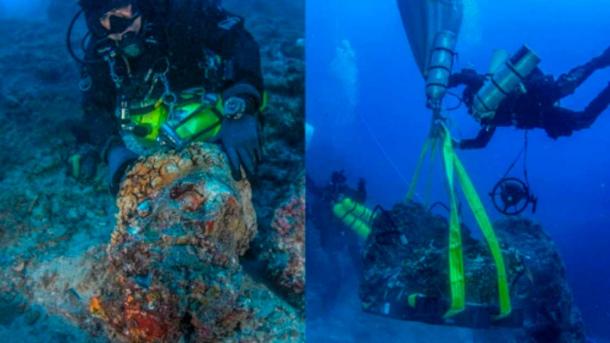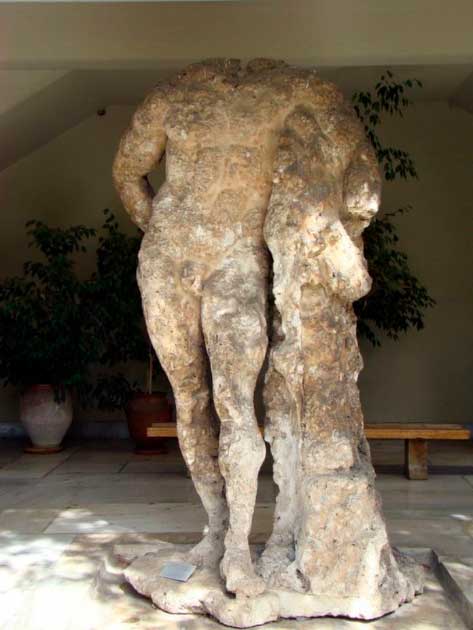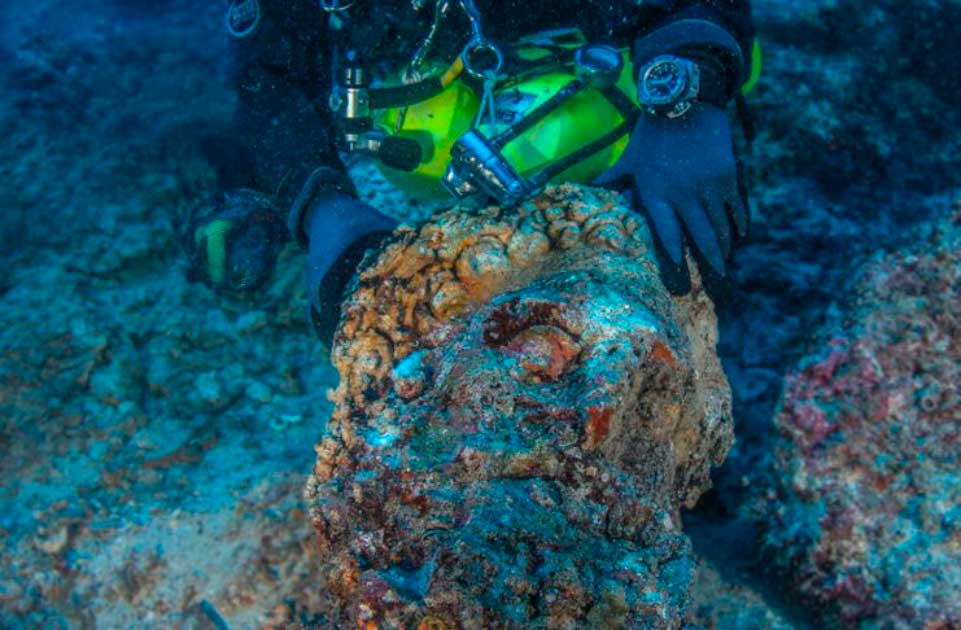Divers Recovered a ‘Herculean’ Marble Head from the Antikythera Shipwreck
For a long time, most only associated the word “Antikythera” with an ancient computer. In 2020, that changed after Greek divers recovered a giant marble head from the world-renowned shipwreck. Discovered in 1900 by sponge divers off Point Glyphadia, on the Greek island of Antikythera, the so-called “Antikythera wreck” is a Roman-era ship dating from the second quarter of the first century BC.
The ship was found to be carrying rare coins, statues, and other artifacts dating back to the 4th century BC. But most famously, it had onboard what is now regarded as the world’s “oldest known analog computer” – the Antikythera Mechanism .
One would be forgiven for thinking the bulk of the bounty had all been stripped from this treasure laden shipwreck, and there is some truth in that. But while the team of scientists from the University of Geneva were moving huge rocks from the seabed around the wreck, they discovered a giant marble bearded head.
Moreover, in addition to two human teeth, encrusted in minerals and mollusks, the divers uncovered an enormous marble base from another statue, with the lower human limbs still attached.

The marble head (left) and a statue base (right) have now been recovered. (Ministry of Culture and Sports)
Correcting Scientific Failings From Yesteryear
In 1900, divers from the Hellenic Navy spent a year salvaging hundreds of ancient artifacts and works of art from the Antikythera shipwreck, which are all on display at the National Archaeological Museum in Athens. Dive records confirm at least one large marble statue was dropped during these recovery operations.
- Obscure Objects Found at Antikythera Shipwreck
- Three Ancient Shipwrecks Still With Cargo Found Off Greek Island
Furthermore, with primitive diving tech having impaired underwater visual technologies, several huge boulders were lifted from the wreck and dumped in deeper waters. It is suspected these mal-interpreted boulders were actually ancient marble statues disguised in sea crust.
Between 2012 and 2019 divers from the Ephorate of Underwater Antiquities of the Hellenic Ministry of Culture and Sports returned to the Antikythera shipwreck. Research continued at the wreck right up until the disruptions caused by the 2021 Covid-19 lockdowns.
Since the giant Antikythera marble head features a bearded male figure, it has been called the “Hercules of Antikythera.” According to Greek Reporter, so convinced are the researchers of the identity of the head that they think it probably belongs to “the headless statue exhibited at the National Archaeological Museum in Athens, which was discovered by spongers in 1900.”

It looks like the giant marble head found next to the famous Antikythera shipwreck may be a match for this headless statue found on the ship in 1900. It is now on display in the National Archaeological Museum in Athens. (F. Tronchin / CC BY-NC-ND)
But Zeus, Poseidon, Hermes, and Dionysus, all had Beards?
Hercules was the Roman demigod that represented a mythological upgrading of the Greek divine hero Heracles. The latter was famed for his adventures, godlike fearlessness, and strength, and in classical mythology Heracles was the son of Jupiter and the mortal Alcmene. However, until the head’s identity is determined it must also be taken into consideration that the classical gods: Zeus, Poseidon, Hermes, and Dionysus, all had beards.
It is interesting to note that ancient Greeks wore beards and tied their hair back in buns, and they only shaved their facial hair while mourning. Of the Romans, Pliny tells us that “P. Ticinius was the first who brought a barber to Rome in the 454th year from the founding of the city.”
This means Romans were bearded until around 299 BC, but this was not the case in the Late Roman Republic (133-31 BC) and the early Principate period (27 BC-284 BC) when the wearing of beards was rare.
- Ancient Treasures Discovered in Roman Shipwreck at Kasos
- Sewage Construction Uncovers Head of Greek God Hermes in Athens
Please don’t be fooled into thinking I am some sort of historical beard specialist, for all the above information comes from the 1897 Harper's Dictionary of Classical Literature and Antiquities. It also says that during the last two mentioned periods in Rome, “a long beard was considered a mark of slovenliness and squalor.”
One can only hope that in the near future my editor asks me to write about the same team of scientists actually matching the giant marble head with the headless torso at the National Archaeological Museum in Athens.
Top image: This marble head, believed to be the head of Hercules, was found next to the legendary Antikythera shipwreck. It may complete a headless statue found on the wreck in 1900 that is now on display in Athens’ largest museum. Source: Ministry of Culture and Sports
By Ashley Cowie



















